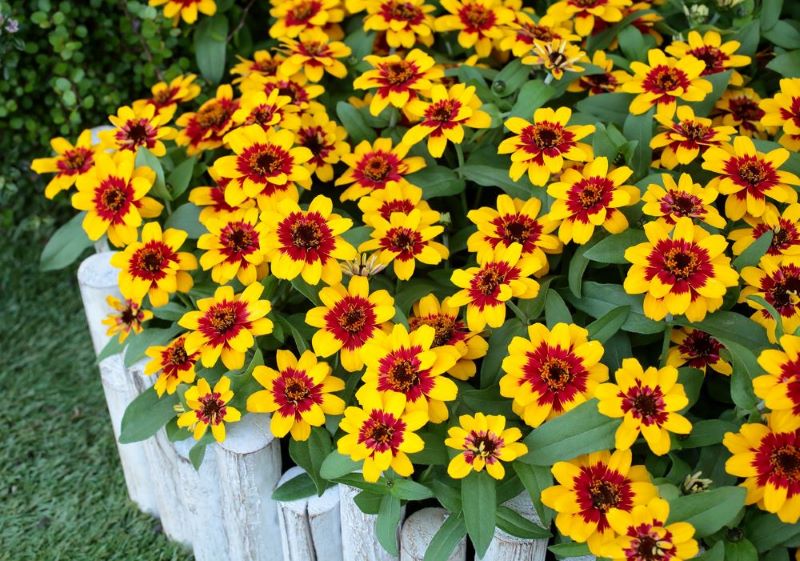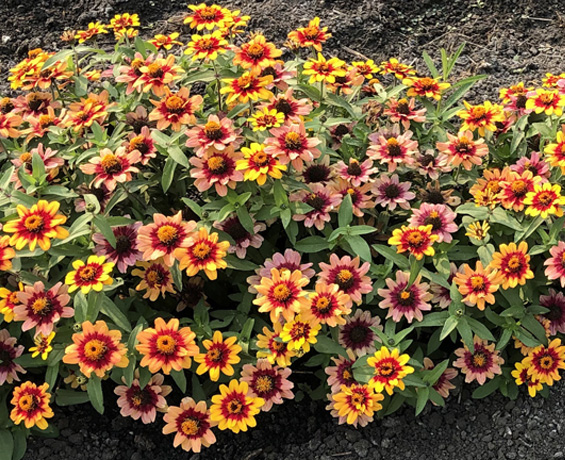
A new variety of zinnia developed by Sakata Seed Corporation, “Profusion Red Yellow Bicolor” (see photo), has been awarded Gold Medals at two of the world’s top flower competitions: All-America Selections (AAS)*1 in the US and Fleuroselect (FS)*2 in Europe. This is the first Gold Medal awarded by AAS in 17 years, and this is the first time in the industry in 17 years that a single variety has been a gold medalist at both AAS and FS.
“Profusion Red Yellow Bicolor” is notable for its distinct red and yellow coloration—the first time this coloration has been achieved in an interspecific zinnia hybrid*3. Conventional varieties have included bicolored flowers, but such varieties have not had consistent coloration, instead becoming monochromatic or having blurred color depending on the cultivation climate and sunlight. “Profusion Red Yellow Bicolor” produces distinctly bicolored flowers that last longer under diverse conditions, and that consistency has earned it high praise from AAS, which grew and evaluated the flowers in various climate zones throughout the US. The variety also received high acclaim at both flower competitions not only for the features of the “Profusion” series, including compactness of plant habit, good flowering count, disease resistance, and continuous flowering habit, but also for the unique characteristic of gradual color changes from bicolored to shades of apricot, pink, and rose as the flowers age.
“Profusion” zinnias are interspecific hybrids that were commercialized in 1999. “Profusion” varieties have won numerous awards at AAS and FS, and they are still popular worldwide leading zinnia varieties more than 20 years after introduction. With this dual Gold Medal win, we aim to further expand sales of the entire “Profusion” series. Seeds for “Profusion Red Yellow Bicolor” will respectively go on sale in North America, Europe, and elsewhere. We plan to make an official introduction for Japanese market in 2022.
The Coloration of “Profusion Red Yellow Bicolor” Flowers

Left: Conventional bicolored variety
Right: “Profusion Red Yellow Bicolor”
The variety on the left looks monochromatic. However, “Profusion” flowers on the right are distinctly bicolored.
Photo taken on April 14, 2016 in Kakegawa, Shizuoka, JAPAN (inside a greenhouse).

As the flowers age, color changes from bicolored to shades of apricot, pink, and rose, a unique trait that has earned high acclaim.
Photo taken on August 21, 2020 in California, USA.
All-America Selections and Fleuroselect, Two of the World’s Top Flower Competitions
All-America Selections (AAS) and Fleuroselect (FS) are global flower competitions who have a long history based in the US and Europe, respectively. They hold a great deal of authority in the flower industry. What both competitions have in common is that they evaluate novel varieties that have never been seen before. In particular, no variety had won the AAS Gold Medal since 2004. The fact that “Profusion Red Yellow Bicolor”, a zinnia developed by Sakata Seed Corporation, won the gold medal is a testament, once again, to the potential of the Profusion series and to Sakata’s development prowess. As of December 7, 2020, “Profusion” series boasts a lineup of more than 10 varieties worldwide. In the past, “Profusion Cherry” (1999), “Profusion Orange” (1999), and “Profusion White” (2001) have also won gold medals at AAS. It is rare for more than one variety in the same series to win awards. One of our employees was also awarded “Breeder’s Cup” by AAS in 2008 for his success in breeding “Profusion” series.
“Profusion” Series of World-Leading Zinnia Varieties
The zinnia is a plant that was originally native to the Americas. It was introduced to Europe in the 18th century and came to be cultivated as a horticultural species. Common varieties have the drawbacks of being vulnerable to disease and hot weather, but today, “Profusion” series developed by Sakata Seed Corporation has become widely popular worldwide as a bedding crop.
The market for zinnia seeds in the US and elsewhere has been growing for the past three years*4, and Sakata expects further growth of the market in the future. “Profusion” series present a strong market position by some of the best varieties available. Going forward, Sakata will continue striving to develop varieties that please customers.
-
*
1 All-America Selections: This non-profit organization was established in 1932 to select and promote superior new varieties of flowers and vegetables. It is the most authoritative trade association in the horticultural industry, pursuing the goal of introducing and promoting new flowerbed flowers for the home gardeners in the US and Canada and allowing the world’s major seed companies to compete and exhibit new cultivars. Cultivation experiments are conducted by dozens of universities, botanical gardens, and seed companies across the North American continent. The best cultivars are selected as award-winning varieties in an event also known as the “Flower Olympics”. Awards are given in four categories: flowers from cuttings, flowers from seed, edibles/vegetables, and herbaceous perennials. Gold medals are only awarded for particularly outstanding plants, and there are not always suitable candidates every year. There is also “Breeder’s Cup”, which is awarded to breeders who have bred noteworthy varieties that have won AAS awards and have made a significant impact in the horticultural industry.
-
*
2 Fleuroselect: In this organization, established in 1970, flower and plant judges evaluate for novelty and practicality of entries at various locations across Europe in order to select award-winning varieties. A Gold Medal is only awarded to varieties demonstrating breakthrough breeding. Due to stringent entry requirements, each company is careful to select and exhibit only the varieties they have the most confidence in. Not only is winning a Fleuroselect award a source of pride for breeders, but it also has a major effect on the ability to popularize new varieties from a commercial standpoint.
-
*
3 Interspecific hybrid: Plants crossbred from two parents of different species within the same genus. Sakata breeding is done by conventional and classical breeding methods.
-
*
4 According to an estimate by Sakata Seed Corporation